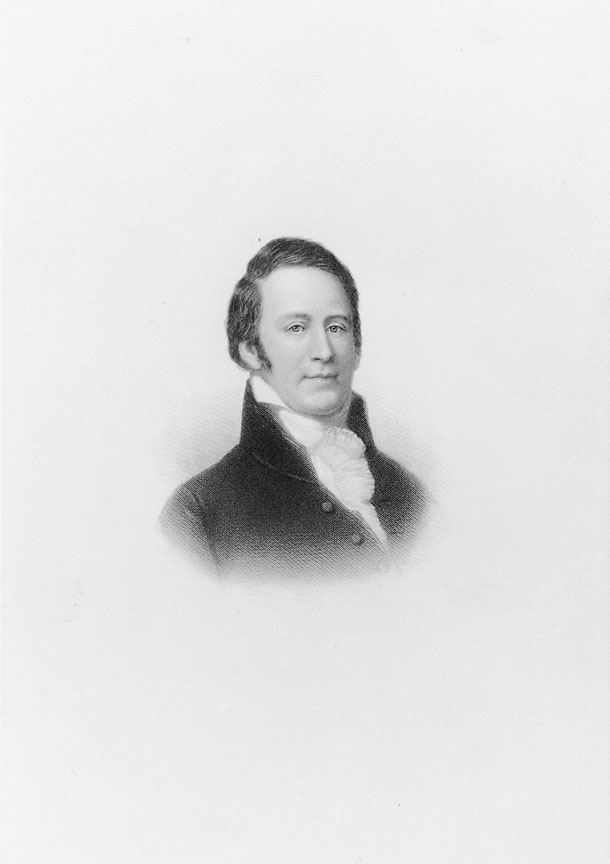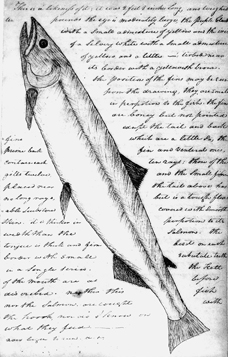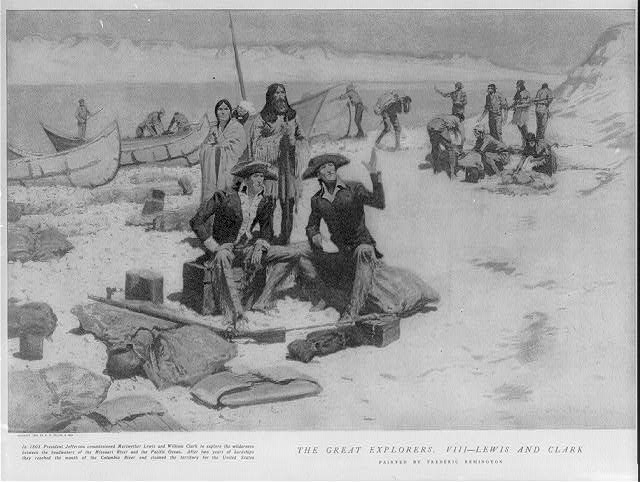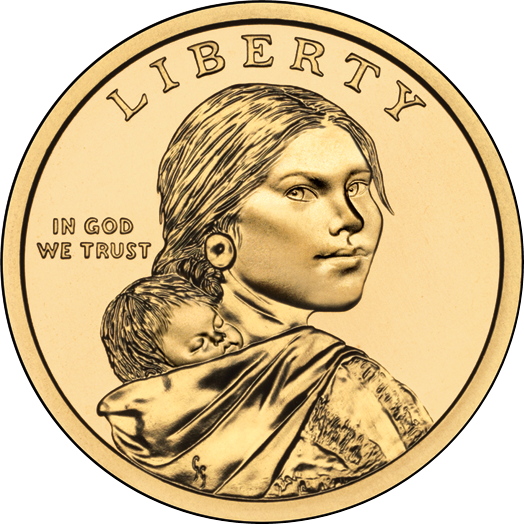William Clark is indelibly connected to Oregon in many ways, some obvious and direct, such as his co-leadership of the Lewis and Clark Expedition in 1804-1806; but others not so evident, such as his reported encouragement of Christian missions to Indians in the American West, which included the first missionaries to come to Oregon during the 1830s. Perhaps most important, Clark created a Master Map of the North American West in 1810, which served nearly all subsequent explorations of the region during the early nineteenth century.
Born in Virginia in 1770, Clark was the ninth of ten children of John and Ann Clark. In 1784, he moved west with his family to Kentucky, near present-day Louisville. His education was informal and based on practical knowledge, not on book-based learning. “Learning does not consist in the knowledge of Languages,” he recorded in a journal entry in the 1790s, “but in the knowledge of things to which language gives names.”
Clark followed his eldest brother, George Rogers Clark, into military life at age nineteen and secured a commission as lieutenant in 1792. By 1794, after participating in campaigns against Indians in the Ohio Valley under Gen. Anthony Wayne, he contemplated leaving the army to “get into some business in Kentucky,” as he wrote his brother Edmund.
On the death of his father in 1799, Clark inherited more than 3,300 acres, twenty-three slaves, a distillery, and gristmill, which made him part of the landed gentry. Nonetheless, family financial distress forced him to sell the farm in 1802, leaving him with an uncertain future. An invitation on June 19, 1803, from his army friend Meriwether Lewis to join him as co-leader in a great military exploration of western North America set him on a course that determined the rest of his life. “The enterprise &c. is Such as I have long anticipated,” Clark replied to Lewis. “I will cheerfully join you . . . and partake of the dangers difficulties, and fatigues, and I anticipate the honors & rewards of the result.”
Although he did not receive a promised commission as captain, Clark served as a coequal leader of the expedition with Lewis, who referred to him as captain throughout the journey. His contributions touched every part of the expeditionary endeavor, especially his surveying and cartography skills, but also his diplomatic engagements with Native people, his steady management of expedition personnel, and his protective attitude toward Sacagawea and her infant son Jean Baptiste Charbonneau. He also brought his personal slave York on the expedition, who had accompanied Clark on military and business journeys for years. Clark did not hesitate to separate York, a man he considered his personal property, from York’s wife in Louisville during the long journey.
During the expedition in Oregon Country, Clark made a significant impression on Nez Perce people, including the nine-year-old son of Twisted Hair, who became Chief Lawyer, a signer of the 1855 Nez Perce Treaty and an advocate of friendship between the Nez Perce and the United States government. Twisted Hair was the expedition’s guide down the Clearwater and Columbia Rivers. Clark’s medical treatments of ailments among Nez Perce on the expedition’s trek west in 1805 and on its return in 1806 also endeared him to the Nez Perce, who considered him a healer. Oral tradition suggests that Clark likely fathered a child with a Nez Perce woman, although there is no definitive evidence.
On the lower Columbia, Clark incorrectly recorded seeing the Pacific Ocean on November 7, 1805; what he actually saw was the river’s expansive and rough estuary. Nonetheless, he made significant charts of the coast and lower river. On the return journey in 1806, he led nine Corps members, along with York, Sacagawea, her husband Charbonneau, and their infant son Jean-Baptiste, to investigate the lower Yellowstone River. On July 25, 1806, about twenty-five miles upriver from present-day Billings, Montana, Clark carved his name on a sizable rock formation, which he named Pompy’s Pillar (renamed Pompey’s Pillar in 1814 by Nicholas Biddle) in honor of Sacagawea’s son, whom Clark called Pomp.
Clark’s group rejoined the expedition on August 12, 1806, on the Missouri River, about thirty miles downstream from the present-day Montana state line, and made St. Louis on September 21. On September 23, he wrote a letter to his brother Jonathan outlining the main events of the journey, which was published in the Frankfort, Kentucky, Palladium on October 9.
Clark served as governor of Missouri Territory from 1813 to 1820, unsuccessfully ran for governor of the State of Missouri in 1820, and served as superintendent of Indian affairs from 1822 to 1838. He retained ownership of York and reportedly refused to give him his freedom until 1816.
An article in the May 1831 Christian Advocate reported the visit of four “Flathead” Indians (actually Nez Perce) to Clark in St. Louis, asking that instructors in Christian theology be sent to the West. Clark did not note the visit in his journals, but his fame and position provided important substance to the story and launched missionary efforts throughout the Pacific Northwest.
In 1808, when Clark was thirty-seven years old, he married sixteen-year-old Julia Hancock. The couple had five children, and she died suddenly in 1820. Clark married Julia’s cousin, Harriet Radford, and fathered three more children before her death in 1831. He died in 1838 at age sixty-eight and is buried in St. Louis.
-
![Captain William Clark, c. 1810]()
Captain William Clark, c. 1810.
Captain William Clark, c. 1810 Courtesy Oreg. Hist. Soc. Research Lib., OrHi97395
-
![William Clark's sketch of a white salmon]()
William Clark's sketch of a white salmon.
William Clark's sketch of a white salmon Courtesy Oreg. Hist. Soc. Research Lib., OrHi96344
-
![William Clark's map of Columbia, Celilo to Fort Rock]()
William Clark's map of Columbia, Celilo to Fort Rock.
William Clark's map of Columbia, Celilo to Fort Rock Courtesy Oreg. Hist. Soc. Research Lib., OrHi105091
-
!["Lewis and Clark at the mouth of the Columbia River 1805." From Colliers Mag., 1906, by Frederic Remington]()
"Lewis and Clark at the mouth of the Columbia River 1805.".
"Lewis and Clark at the mouth of the Columbia River 1805." From Colliers Mag., 1906, by Frederic Remington Courtesy Library of Congress, Mag_LOT 4392-N
Related Entries
-
![Columbia River]()
Columbia River
The River For more than ten millennia, the Columbia River has been the…
-
![Lewis and Clark Expedition]()
Lewis and Clark Expedition
The Expedition No exploration of the Oregon Country has greater histor…
-
![Sacagawea]()
Sacagawea
Sacagawea was a member of the Agaideka (Lemhi) Shoshone, who lived in t…
-
![York (ca. 1770–?)]()
York (ca. 1770–?)
York was William Clark's slave and an integral member of the Lewis and …
Related Historical Records
Map This on the Oregon History WayFinder
The Oregon History Wayfinder is an interactive map that identifies significant places, people, and events in Oregon history.
Further Reading
Foley William. Wilderness Journey: The Life of William Clark. Columbia: University of Missouri Press, 2004.
Steffen, Jerome O. William Clark: Jeffersonian Man on the Frontier. Norman: Univ. of Oklahoma Press, 1977.
Jones, Landon Y. William Clark and the Shaping of the West. New York: Hill & Wang, 2004.
"Clark to Lewis, July 18, 1803." In Letters of the Lewis and Clark Expedition Second Edition, Vol. 1., edited by Donald Jackson. 10. Urbana: Univ. of Illinois Press, 1978.
Evans, Steven R. and Allen V. Pinkham. Lewis and Clark Among the Nez Perce. Mandan: Dakota Institute, 2013.
Holmberg, James J. Dear Brother: Letters of William Clark to Jonathan Clark. New Haven, Yale Univ. Press, 2002, 101-106.
Furtwangler, Albert. Bringing Indians to the Book. Seattle: Univ. of Washington Press, 2005.







